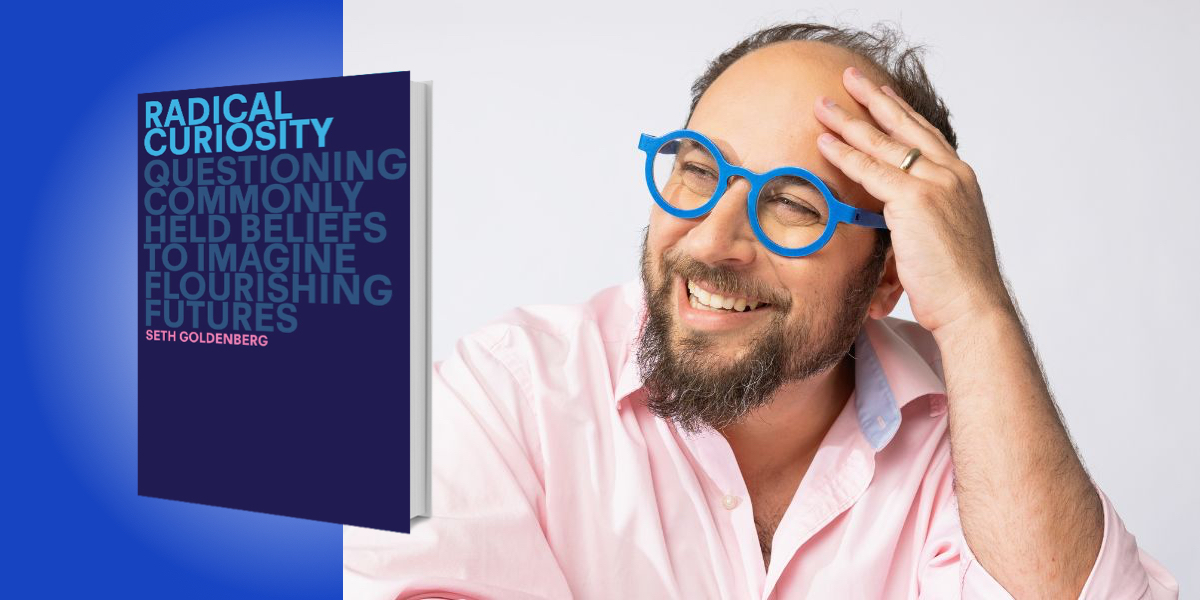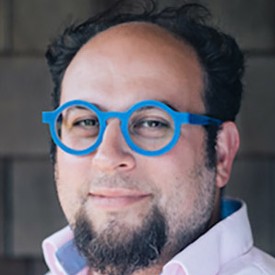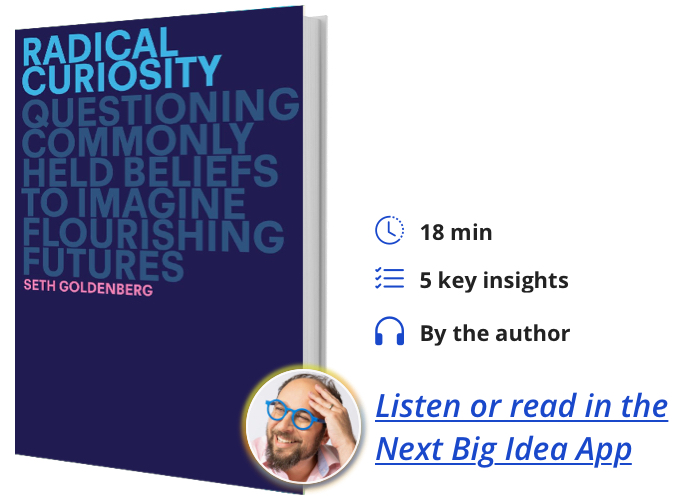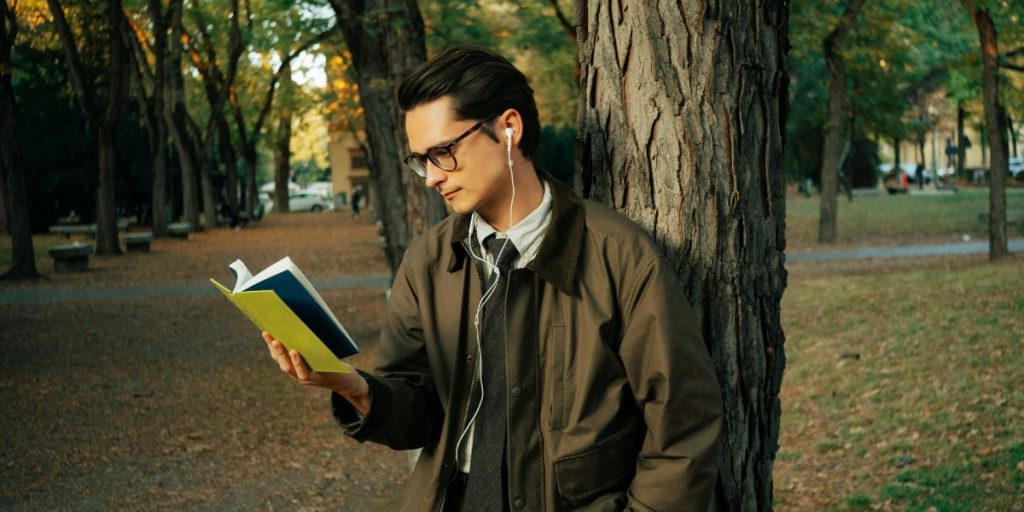Seth Goldenberg is a designer, activist, curator, and founder and CEO of Curiosity & Co. Goldenberg has designed retreats and thought projects for Apple, American Express, the Oprah Winfrey Network, and the Governor of Rhode Island, among others.
Below, Seth shares 5 key insights from his new book, Radical Curiosity: Questioning Commonly Held Beliefs to Imagine Flourishing Futures. Listen to the audio version—read by Seth himself—in the Next Big Idea App.
1. Curiosity is an endangered species.
Our modern world has been designed to eradicate curiosity. At a time when every sector of business and society is facing existential challenges, the potential extinction of curiosity is an emergency. We need questions now more than ever. We often move too swiftly towards solutions, acting before we identify the true, essential question that we seek to solve. We wear our action-oriented mindset like a badge in contemporary business, saying things like, “I have a bias for action,” but we have confused the act of the transaction with actual impact. We reward the mere swing of the hammer, even when we have missed our mark throughout the 20th century.
Knowledge has become segregated, industrialized, and routinized. We view thinking as a commodity. Leading has come to mean the management of preexisting knowledge rather than the discovery of new knowledge. Many of us, in our personal and professional lives, get occupied in the transactions, the routines and mere tactical activities that overshadow the questions of why? Why are we doing what we do? Do we have the power? Do we have the authority to question the trajectory in the first place? We live in a time of consistent paradoxes. We don’t know for certain that education is working, but we will throw you in jail if you don’t attend. Our social systems are designed as paradoxes, and we’re letting it pass us by, moving the chairs on the Titanic as we head into the crisis that we didn’t recognize as the root.
2. We are living during the in-between times.
These in-between times are a kind of interregnum. In politics, the term interregnum is defined as a pause between two successive regimes, often viewed as a period juxtaposed between two different ideologies. This kind of interregnum is quite tangible, marked by milestones of change in government. Today, however, we’re living in a more abstract, but no less significant type of interregnum, one that is cultural rather than political. We are living between models of how we see ourselves, what we believe in, and how we agree to realize those values. It’s as though society is stitched together through a shared code of what we believe, and we translate those beliefs into the way we choose to live. This is similar to an operating system within our computer that dictates the basic functions it performs. Culture is a kind of operating system that guides how society functions; a set of rules and behaviors and collectively accepted values that encode through millions of micro-agreements that keep the system running.
“As challenger narratives become newborn babies that are still learning to crawl, they begin to catch the public imagination and mature into a more predominant narrative.”
A cultural interregnum, though, is a unique moment during which ideas from the past are in decline as we question them as potential legacy narratives. In turn, the new ideas, and the new possibilities that emerge are challenger narratives. This progression from legacy narratives to challenger narratives makes up this messy middle of the in-between times. We are witnessing meaningful and diverse experimentation with new ideas that challenge our deeply-held core beliefs about ourselves, our business, our culture, and our definition of humanity. Legacy narratives often have a stronghold over the public imagination. They carry entrenched traditions and associated messages that reinforce the narrative and power structures that anchor the identities by which we live. As challenger narratives become newborn babies that are still learning to crawl, they begin to catch the public imagination and mature into a more predominant narrative. There is friction, of course, a kind of growing pain that we experience between these two narratives, which is the moment in which we are currently living.
3. We need “fourth places” propelled by civic imagination.
Society is going through an operating system reboot, redefining what we believe in and what we value. We are recoding big ideas, from gender to the economy, from the workplace to health. How do we go about rewriting that code? How do we cooperatively and collectively experiment? How do we determine which narrative will emerge next? Which narrative will prevail and become a predominant narrative, eventually evolving into a legacy narrative?
We need to invest in what sociologist Ray Oldenburg called “third places.” Oldenburg defined these as places distinct from our home, which may be the first place, and work, the second. Third places are places where people exchange ideas and build relationships that strengthen social capital. Examples of third places are recreation centers, parks, pubs, hair salons—gathering places that bring cohesion to our social selves.
“We need gathering spaces for championing unheard voices, examining emerging narratives, and drawing upon our collective creative capacity to build and realize new kinds of futures.”
Simply gathering, however, may not itself be sufficient for the complexity of what we’re facing. We need spaces that ignite the revolutionary spirit, spaces where we define the chapter of what comes next. We need gathering spaces for championing unheard voices, examining emerging narratives, and drawing upon our collective creative capacity to build and realize new kinds of futures. We need fourth places. They are much-needed additions to the three spheres Oldenburg articulated more than three decades ago. The future is a dimension to which we, as stakeholders, need to pay attention. The fourth place is where we reclaim our identity as civic actors, responsible for shaping the emergent future. It is a place where we can bridge our public and private selves, manifesting a sense of purpose as we imagine and build what comes next. Since this future remains uncertain, these next steps will require conversation and curiosity.
4. The ultimate outcome of design is aliveness.
Design thinking has become a competitive advantage in business and civic life. We need to ask more of design. We’re only now beginning to scratch the surface of what design really means and design’s role in society. What is the highest-order outcome that design can offer?
Aliveness is what we experience at the highest-order version of ourselves. To realize such a heightened state requires imagination. Aliveness can only occur when we imagine a possible self that pierces through the mundane and becomes extraordinary. This is the greatest gift of imagination, our ability to bridge the gap between possibility and realization. We are deeply moved when we watch the performances of our friends, colleagues, or ourselves peak at a performative event or milestone. We are witnessing someone have an experience with the highest order of themselves.
Aliveness is about our ability to love life, to show up for it, and devour it as a meal. We cannot realize this by bringing harm to others. We cannot self-actualize without collective actualization. This is the great context design project of the century. It will measure the sum of us, not the singularity of individuals. It is our moral responsibility to be alive.
5. Imagination is the most valuable natural resource on earth.
In 2010, IBM produced a landmark study involving more than 1,500 CEOs from 60 countries across 33 industries, exploring what they believed to be the most crucial factor for future business success. A surprising theme emerged more than any other skill traditionally associated with the business. The number one quality CEOs cited was creativity. In interviews, these executives indicated that in an environment of increased complexity and ambiguity, requiring business-model change and the ability to invent and navigate disruptive innovation, creativity should be prioritized above all else.
“The wicked challenges we face are, for better or worse, outcomes of our own success.”
Yet society does not prioritize imagination in business, government, or education. The evidence of this is staggering. In 2020, for the fourth consecutive year, the Trump administration announced its proposed annual federal expenditure, ironically titled Budget for America’s Future. The budget eliminated the National Endowment for the Arts and the National Endowment for the Humanities. The final version, thankfully, allowed an allocation of approximately $160 million for the NEA. By contrast, that same year, the federal allocation for the Department of Defense exceeded $700 billion, making the federal arts budget .02 percent of the military budget. Hold that in the air for a moment. The tools of imagination were valued at two-hundredths of a single percent of the tools of war.
Imagination is a renewable resource. It is rooted in a phenomenon known as mental synthesis, defined as our brains’ ability to combine known concepts to make new ideas. This capability is considered uniquely human, something that differentiates us from other living beings. The wicked challenges we face are, for better or worse, outcomes of our own success. Considering that we have imagined the current state of the world, we can reimagine our way out of it. Maya Angelou once said “creativity cannot be used up. The more you use, the more you have.” Imagination may very well be the most valuable natural resource in the world.
To listen to the audio version read by author Seth Goldenberg, download the Next Big Idea App today:






























